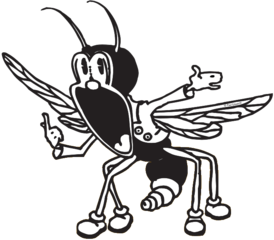Jim Crow Museum
1010 Campus Drive
Big Rapids, MI 49307
[email protected]
(231) 591-5873
 Q: I read your article on racism in mascots from 2015. I was digging for information about the 1930's Hornet mascot for the Emporia State
University in Emporia, Kansas.
Q: I read your article on racism in mascots from 2015. I was digging for information about the 1930's Hornet mascot for the Emporia State
University in Emporia, Kansas.
I upset my daughter. She toured there yesterday & they gave her a t-shirt with their mascot circa 1930 on it. I thought it was a racist characterization of a hornet. She just thought it was just a cute hornet.
She agreed to check with you all on this, before wearing it. So, in your humble opinion,
and those of your esteemed colleagues at the Jim Crow Museum, am I reading too much
into this, or is this racist?
~ Elizabeth M.
Lawrence, Kansas
A: Thank you Elizabeth for contacting the Jim Crow Museum. I did a little research and
found that the Emporia State (formerly Kansas State Teachers College of Emporia) mascot
was created by Paul Edwards in 1933, a student at the time. Edwards’ hornet was the
chosen design from a contest to represent “Corky,” the mascot of the school. Edwards
would go on to draw each version of the mascot until his death in 2018. Edwards attended
art school in Los Angeles after graduating from Kansas State Teacher College of Emporia,
and later he worked as an animator for Disney Animation Studios.
Looking at the early hornet design, one can see the Disney animation influences in Edwards’ work. As you probably know, Disney had many early characters, particularly in the 1920s, 1930s, and 1940s that were blatantly racist.
However, it is hard to tell what is intended in the drawing of the Corky mascot. I do see similarities to some caricatured African American cartoons, such as the over-exaggerated mouth expression with the outlined white lips, but without other cartoon characteristics of the hornet displayed, (i.e. gait, dialect, etc…) I don’t think it is clear that this hornet was a caricature of African Americans.
Disney ran a series of Silly Symphony animations in the late 1920s and early 1930s and the style used to draw Corky the Hornet is really similar to many of the insects of the 1930 “Silly Symphony -Summer.”
In this animation, I think some people might argue that some of these insects are caricatured black people, but I think other people could argue that they are not. There are a few scenes that are more questionable. At about the 3:50 mark and in the end scenes with the spider, one could make the argument that these are similar to other black caricatured animations. However, I wouldn’t make that determination without seeing additional characteristics of caricature in the animation such as certain dances, gaits, dialect, “old plantation” type music, and so on.
Speaking of the Silly Symphony animations, Disney had no problem using obvious caricatures and stereotypes in other cartoons in the series. In this “Midnight in a Toy Shop” scene, there is a black Topsy toy doll that is unmistakably drawn as a black caricature, does a little dance and says “Mammy” a number of times after a few moves. You’ll also see many Asian stereotypes and caricatures in “The China Plate” animation from 1931. And in this 1931 “Egyptian Melodies” animation there are some black caricatured hieroglyphics performing in the film.
I was not able to access many of the early versions of the Emporia State Corky mascot through online catalogs, newspapers, or yearbooks. However, I found a 2009 Spotlight article that mentioned the 1935 KTSC yearbook, the Sunflower, which had a series of pictures of Corky just inside the front cover. The cartoon did not display any overt racial iconography. The article also stated that in the 1930s the student newspaper, the Bulletin, published a cartoon called “Corky’s Comments.” Emporia State sent us a few copies and there were no racial overtones in the cartoons.
In the relatively small sample of images I have seen of Corky, I would say that the character does not appear to display any racist characteristics or racial stereotypes.
Hope this helps.
Franklin Hughes
Jim Crow Museum
2021
Resources
Kansas State Teachers College of Emporia. (1935). Sunflower.
Tuel, J. (2009). Spotlight, 39 (2), 10–13.
Walt Disney Productions. (1931). The China Plate. United States. https://www.youtube.com/watch?v=jRd5FauPdDg&t=975s
Walt Disney Productions. (1931). Egyptian melodies. United States. https://www.youtube.com/watch?v=jRd5FauPdDg&t=2467s
Walt Disney Productions. (1930). Midnight in a Toy Shop. United States. https://www.youtube.com/watch?v=Amje0ryexmk&t=3235s
Walt Disney Productions. (1930). Summer. United States. https://www.youtube.com/watch?v=psIMCYg4bQE
YouTube. (2016). Silly Symphony Compilation - Volume 2 - 1930-1931 (Best quality). YouTube. https://www.youtube.com/watch?v=jRd5FauPdDg&list=PLxf0FUnNFREd5Vo57pyhavO_Faz7PDnx3&index=2
YouTube. (2016). Silly Symphony Compilation - Volume 1 - 1929-1930 (Best quality). YouTube. https://www.youtube.com/watch?v=Amje0ryexmk&t=3235s